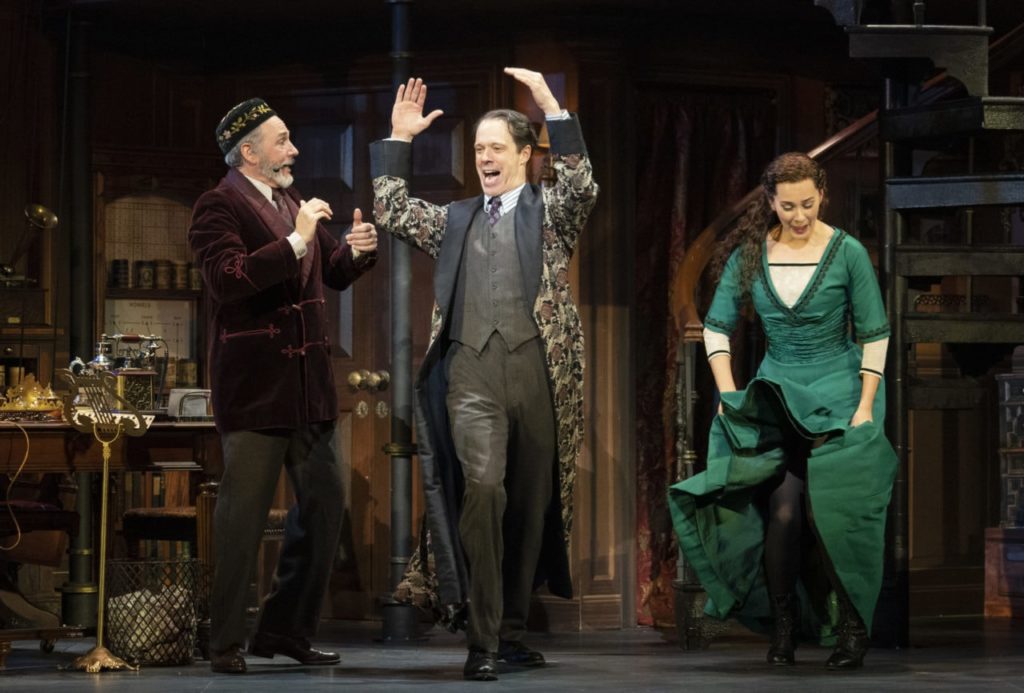‘My Fair Lady’ at the Kennedy Center
By • December 23, 2019 0 1533

If you watched the opening scenes and even a large part of Lincoln Center’s shining and compulsively engaging production of Lerner and Loewe’s classic musical “My Fair Lady” — playing in the Kennedy Center Opera House through Jan. 19 — you might think you were back in the day.
The day, that is, depending on your experience, of seeing and hearing Rex Harrison as Professor Henry Higgins to Julie Andrews (stage version) or Audrey Hepburn (movie version) as Eliza Doolittle. The top hats, the gray suits, the elegant, buoyant upper-shelf Edwardian dresses, the garrulous lower-level types with the impenetrable accents, the white carpet of the Ascot races, not to mention the indelibly cherished score — they’re all here and here you are.
But then again, you’re not.
Every word and line, and all the lyrics and melodies, are here, but they’re not quite the same. They feel, in fact, as if you’ve passed across a border into another country. The much-honored director Bartlett Sher (Tony award for “To Kill a Mockingbird” and Outer Critics Circle Award for “My Fair Lady”) has a gift and a flair for passing his creative wand over beloved, perhaps overly familiar gems and making them seem part of our contemporary lives.
This is not a question of tricks of the stage or mere relevancy. Sher is a director who knows how to remember where things come from, while paying attention to his current surroundings. He’s also a master entertainer.
The show is, first of all, eye candy. Set designer Michael Yeargan makes us feel equally at home in the soggy cobbles of London’s flower peddlers and cab callers and the musky mahogany of intellectual gentlemen’s domiciles. Costume designer Catherine Zuber dazzles with both highbrow gowns for balls and races and lowbrow getups for pub crawlers. She surprises us with aplomb when the chums of Eliza’s dad, with deep reluctance on his way to getting married, celebrate with a chorus line that seems to have hitched a ride from a “Cabaret” road show.
That aside, you are still dealing with Higgins, a famed linguist who decides on a bet with his old friend Colonel Pickering to turn a barely intelligible flower seller into a smashing, elegant, dazzling tiara-class aristocrat, speaking the King’s English like a queen.
That’s the conceit, the punch and punch line, but — based on George Bernard Shaw’s play “Pygmalion” — “My Fair Lady” is also a battle of the sexes and a Shavian disquisition on gender, class and culture.
And it is a battle royal. There is an initial spark between teacher and pupil, but it’s hard to tell at the start (and at the end, too) what kind of passion is involved. Changing someone completely is hard work, and being changed is harder.
“My Fair Lady” is a bit of a dream, but it’s a dazzling dream, an affecting dream, a treasure trove of beautifully sung music, running with great flair and emotion through Eliza’s “Wouldn’t It Be Loverly,” good old dad’s bouncy “With a Little Bit of Luck” and rousing “Get Me to the Church on Time,” Eliza’s deliriously imagined “I Could Have Danced All Night” and potential beau Freddy’s “On the Street Where You Live.”
For that and all the rest to work, and also become something different than before, you need to forget the past — forget Hepburn and, most of all, forget Harrison’s speaking-singing and regal posture. You need to take this Higgins at face value, as Laird Mackintosh embodies him. He’s haughty and arrogant, all right, but he’s also energetic, even frisky. He moves as if bouncing off a trampoline, and he speaks his lines and actually sings at almost the same pace.
Shereen Ahmed is another matter entirely. An actress-singer of top-drawer quality, even when she’s mangling the English language into a painful cat’s meow, she has the kind of rangy, deeply emotional high voice that improves the unimprovable. She is a winner, just waiting to show her stuff, and you root for her from the get-go.
She, and she alone and the times around us change everything. The education of Eliza Doolittle and what happens afterwards — will she stay or will she go? — is a power struggle and a struggle to change. She doesn’t need Higgins to tell her that a woman like her is valued in terms of how she’s treated.
This is #MeToo writ large and beautifully and sharply. Higgins’s “Why Can’t a Woman Be More Like a Man?” bites in both the colloquial and actual sense, because he puts so much genuine frustration into the words.
Lerner and Loewe didn’t create a political screed here (although Shaw probably did), because “My Fair Lady,” and this production particularly, is about pure pleasure, too. It’s like a song you’ve suddenly learned to sing, a dance you can, just this once, dance perfectly.

